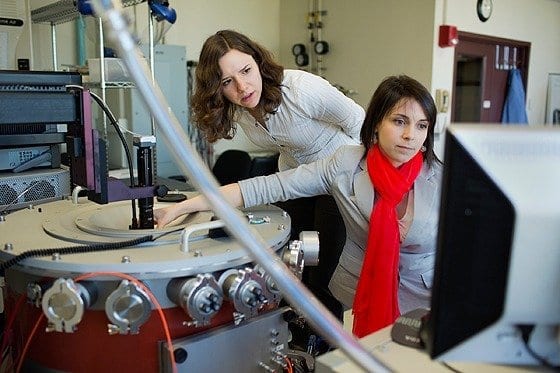
New hardware could lead to wireless devices that identify and exploit unused transmission frequencies, using radio spectrum much more efficiently.
The way in which radio spectrum is currently allocated to different wireless technologies can lead to gross inefficiencies. In some regions, for instance, the frequencies used by cellphones can be desperately congested, while large swaths of the broadcast-television spectrum stand idle.
One solution to that problem is the 15-year-old idea of “cognitive radio,” in which wireless devices would scan their environments for vacant frequencies and use these for transmissions. Different proposals for cognitive radio place different emphases on hardware and software, but the chief component of many hardware approaches is a bank of filters that can isolate any frequency in a wide band.
Researchers at MIT’s Microsystems Technology Laboratory (MTL) have developed a new method for manufacturing such filters that should improve their performance while enabling 14 times as many of them to be crammed on a single chip. That’s a vital consideration in handheld devices where space is tight. But just as important, the new method uses techniques already common in the production of signal-processing chips, so it should be easy for manufacturers to adopt.
There are two main approaches to hardware-based radio-signal filtration: one is to perform the filtration electronically; the other is to convert the radio signal to an acoustic signal — a physical vibration — and then convert it back to an electrical signal. In work to be presented in June at the International Conference on Solid-State Sensors, Actuators and Microsystems, Dana Weinstein, the Steve and Renee Finn Career Development Assistant Professor of Electrical Engineering and Computer Science, and Laura Popa, a graduate student in physics, adopted the second approach.
Resonant ideas
Both types of filtration use devices called resonators, and acoustic resonators have a couple of clear advantages over electronic ones. One is that their filtration is more precise.
“If I pluck a guitar string — that’s the easiest resonator to think of — it’s going to resonate at some frequency, and it’s going to die down due to losses,” Weinstein explains. “That loss is related to, basically, energy leaked away from that resonance mode into all other frequencies. Less loss means better frequency selectivity, and mechanical acoustic resonators have less loss than electrical resonators.”
Acoustic resonators’ other advantage is that, in principle, they can be packed more densely than electrical-filtration circuits. “Acoustic wavelengths are much smaller than electromagnetic wavelengths,” Weinstein says. “So for a given frequency, my mechanical resonator is going to be much smaller.”
But in practice, the number of acoustic resonators in a filtration bank has been limited. The heart of any device that converts electrical signals to mechanical vibrations, or vice versa, is a capacitor, which can be thought of as two parallel metal plates separated by a small distance.
“The capacitors change the impedance” — a measure of the ease with which a wave propagates — “that the antenna sees, so you may have unwanted reflections back into the antenna,” Weinstein says. “Each capacitor from each filter is going to affect the antenna, and that’s no good. It means I can only have so many filters, and therefore so many frequencies that I can separate my signal into.”
Another problem with acoustic resonators is that turning them on or off — a necessary step in the isolation of a particular transmission frequency — requires giving each resonator its own electrical switch. Traditionally, an incoming radio-frequency signal has had to pass through that switch before reaching the resonator, suffering some loss of quality in the process.
Switching channels
Weinstein and Popa solve both these problems at a stroke. Moreover, they do it by adapting a technology already common in wireless devices: a gallium nitride transistor.
The Latest Bing News on:
Frequency-hopping radios
- High-intensity spatial-mode steerable frequency up-converter toward on-chip integrationon May 1, 2024 at 1:13 pm
Electronic Science discusses high-intensity spatial-mode steerable frequency up-converter toward on-chip integration. Integrated photonic devices consisting of micro-lasers, amplifiers, ...
- FCC Asked To OK Canadian FM’s Frequency Shifton May 1, 2024 at 12:12 pm
What jurisdiction does the FCC possess to move forward with the proposed change in FM frequencies for two stations, including a Canadian operation? Plenty, it turns out, as this Canadian FM is ...
- Rakuten Mobile Launches 700 MHz 'Platinum Band' Radio Frequency Trialson April 30, 2024 at 7:40 pm
Spectrum in the 700 MHz platinum band offers better indoor building penetration and enables better connectivity indoors and in underground locations. Rakuten Mobile plans to gradually deploy platinum ...
- CTA Centennial Part 3: The TV Ageon April 30, 2024 at 6:00 am
The 1950s was dominated by the rapid rise of television. By 1955, U.S. TV household penetration leaped to 64.5%, by 1960, it reached 87.1%.
- Resisting Enemy Drone Jamming Attempts: Red Cat, Doodle Labs Electronic Warfare Tests in Ukraineon April 25, 2024 at 12:43 pm
Red Cat and Doodle Labs Triumph in Electronic Warfare Tests in Ukraine: collaboration demonstrates enhanced anti-jamming capabilities for drones amid ongoing military challenges. Red Cat Holdings, Inc ...
- Red Cat Successfully Passes Field Testing with Doodle Labs Against Electronic Warfare Technology in Ukraineon April 25, 2024 at 7:31 am
The ongoing partnership between Red Cat and Doodle Labs is addressing the growing need by the U.S. and its allies for small, autonomous, and attritable drones equipped with anti-jamming radios capable ...
- CTA Centennial Part 2: David Sarnoffon April 23, 2024 at 6:00 am
No one in our industry’s history combined the will, power, ego, and ambition David Sarnoff wielded to transform his technology dreams into reality.
- 9 life-changing inventions by these women that transformed everyday lifeon April 20, 2024 at 4:47 am
Meet nine pioneering women whose inventive genius has transformed everyday life with groundbreaking creations. From ...
- Up Close: AeroVironment CEO Wahid Nawabion April 18, 2024 at 9:08 am
Wahid Nawabi, CEO, AeroVironment, outlines the evolving landscape of autonomous defense, emphasizing the importance of AI, computer vision, and collaborative au ...
- Jam-Resistant American Radio Keeps Ukraine’s Long-Range Drones Flyingon April 17, 2024 at 1:52 am
The Mesh Rider radio built by U.S. company Doodle Labs is a crucial component in Ukraine's battle to keep their drones operating against Russian electronic warfare.
The Latest Google Headlines on:
Frequency-hopping radios
[google_news title=”” keyword=”frequency-hopping radios” num_posts=”10″ blurb_length=”0″ show_thumb=”left”]
The Latest Bing News on:
Cognitive radio
- Morehouse Graduate Calls for Leadership and Transparency in Response to President Biden's Commencement Addresson May 1, 2024 at 8:16 am
In a recent interview on The Rashad Richey Morning Show, a recent Morehouse College graduate, Qualon Bobbitt shared his thoughts on the upcoming commencement address by President Joe Biden.
- PIP changes: Everything you need to know if you receive disability benefiton May 1, 2024 at 5:19 am
The government is looking at changing who is eligible for PIP, how decisions on it are made and the method by which recipients are compensated.
- 30+ Facts That Will Probably Teach You Something Newon May 1, 2024 at 4:44 am
The world is full of fascinating facts, some well-known, others hidden in plain sight. Have you ever wondered why we shouldn’t interrupt conversations to move out of the way, or why the “Happy ...
- Is there a disease, an addiction, or a body part that Ozempic can’t make better?on April 30, 2024 at 5:00 pm
Every single database showed a lower risk for cognitive impairment or dementia among people whose ... Prior to working here, he was a programming consultant for radio and TV stations in some 20 ...
- Cognitive tests to assess driver impairment called into questionon April 30, 2024 at 4:45 pm
Grey Power is calling for a change to elderly driver assessments, claiming the process for assessing driver capability is penalising some of the very people who need their licences the most.
- N.L. government begins plan to clear out St. John's tent encampmenton April 30, 2024 at 3:17 pm
The Newfoundland and Labrador government is putting its foot down on the tent encampment in Bannerman Park in St. John's, posting signs that say any tent or unauthorized semi-permanent structure will ...
- How do you counter misinformation? Critical thinking is step oneon April 30, 2024 at 8:30 am
Another group completed a "a personality test that shows them their cognitive traits and how this makes them prone to behavioral biases." The basic idea is they see their biases in action and become ...
- Stephen L. Carter: The left’s calls for Sonia Sotomayor to retire are absurdon April 29, 2024 at 7:05 pm
The left’s absurd calls for Justice Sonia Sotomayor to step down so President Joe Biden can name a younger replacement should be roundly condemned. Such pressure is an American tradition ...
- The Latest Online Culture War Is Humans vs. Algorithmson April 29, 2024 at 4:00 am
Ever feel like Instagram or TikTok algorithms know you a bit too well? The backlash against automated curation is building, and new algorithm-free platforms are springing up.
- Does 'Brain Training' Really Improve Cognition and Forestall Cognitive Decline?on April 29, 2024 at 12:32 am
Some companies claimed that engaging in "brain games" can improve cognition or stave off cognitive decline. What's the evidence and do crosswords and Sudoku count?
The Latest Google Headlines on:
Cognitive radio
[google_news title=”” keyword=”cognitive radio” num_posts=”10″ blurb_length=”0″ show_thumb=”left”]










